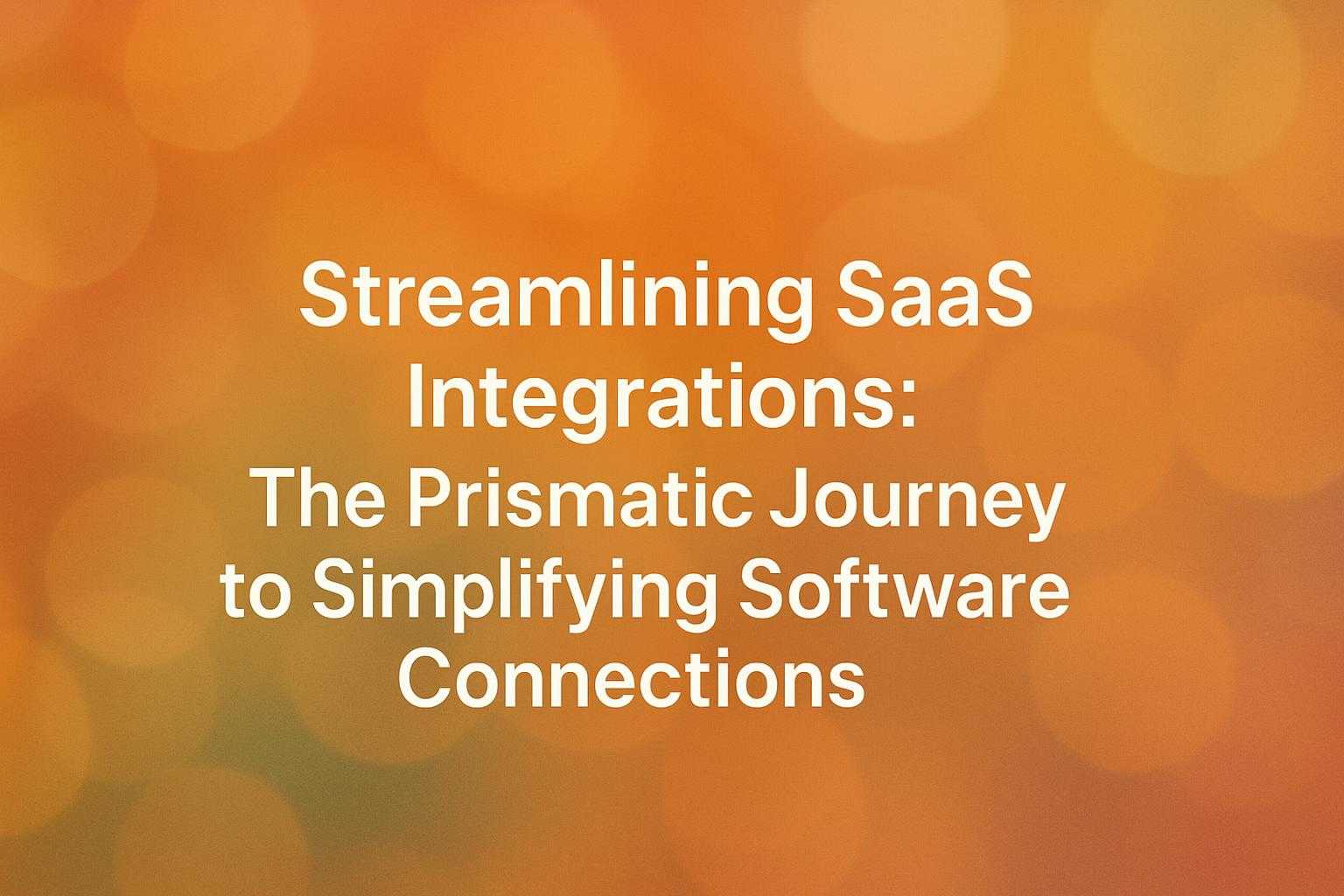Streamlining SaaS Integrations: The Prismatic Journey to Simplifying Software Connections

Company profile
Company business details
Motivation to build the product
The founders were motivated by the need to simplify the integration process for SaaS companies, recognizing that many faced challenges in connecting their software products with other tools. Their experience in the tech industry highlighted the inefficiencies in existing solutions, prompting them to create a more effective platform.Problem that their product solves
Prismatic solves the problem of complex software integrations for B2B SaaS companies. The end users are developers and product teams who need to connect their applications with other tools efficiently. Solving this problem is crucial as it allows companies to enhance their value proposition and focus on product innovation rather than integration challenges.Their unfair advantage
Prismatic's unfair advantage lies in its ability to provide both low-code and code-native experiences, catering to a wider range of users and allowing for more flexibility in integration processes.Strategies
Idea Validation Stage
Customer Conversations for Validation
In the early days of Prismatic, Michael Zuercher and his co-founders spent significant time engaging in conversations with potential customers to validate their idea. They reached out to industry leaders and tech business experts to discuss the integration challenges they faced. This process helped them understand the market needs and refine their product concept, ensuring they were not just creating a solution in search of a problem. They focused on identifying their ideal customer profile (ICP) and gathering insights that would shape their product development and messaging strategy.
Pre-Launch (Product Development & MVP)
Design and Engineering Integration
Prismatic's founder, Robert Cross, emphasized the importance of integrating design and engineering from the very beginning. He and his co-founder, Arya, dedicated significant time to learning design principles themselves, which allowed them to communicate effectively with designers and engineers. This hands-on approach helped them create a product that was not only functional but also visually appealing, ensuring that both teams worked in unison to enhance user experience. They spent about 12 months refining this integration, which was crucial for the product's development.
Building a Prototype for Conversations
During the first 8-9 months of Prismatic's journey, the founders dedicated their efforts to building a prototype of their integration platform. This prototype was not intended for production use but served as a 'prop' for discussions with potential customers. They used this early version to demonstrate their vision and gather feedback, which was crucial for refining their product before launching a production-ready version. This approach allowed them to engage with prospects and iterate on their product based on real-world input.
Customer-Centric Product Development
Before launching Prismatic, Michael Zuercher and his co-founders engaged in extensive conversations with potential customers to understand their integration challenges. They gathered insights from hundreds of discussions, which guided the development of their platform. This customer-centric approach ensured that the features they built were directly aligned with the needs of B2B SaaS companies, allowing them to create a product that effectively addressed real pain points in the market.
Launch Stage
Refining Messaging and Value Proposition
As Prismatic prepared for its launch, the team faced the challenge of articulating their unique value proposition in a crowded market. It took them about a year to develop clear messaging that distinguished their platform from existing integration solutions like MuleSoft and Zapier. They focused on communicating how Prismatic helped SaaS companies connect their products to other software used by their customers, which was a different problem than traditional integration platforms addressed. This clarity in messaging was essential for attracting early customers and gaining traction.
Educational Market Penetration
Upon launching Prismatic, the team recognized that embedded iPaaS was a relatively new concept for many B2B SaaS product leaders. To address this, they focused on educating the market about the benefits of their platform. They created informative content and resources that highlighted how Prismatic could streamline product integrations, thereby breaking through the initial barriers of awareness and understanding in the industry.
Growth Stage
Thoughtful Recruitment Process
To build a strong team, Prismatic focused on a thoughtful recruitment process that showcased their commitment to design and engineering. They approached potential hires with personalized messages, highlighting specific reasons why they would be a great fit for the company. This included sharing information about the company culture and the collaborative environment they fostered between designers and engineers. They also created a 'people page' on their website to give candidates insight into the backgrounds of the team members, making the recruitment process more engaging and informative.
Creating a Collaborative Office Environment
Prismatic structured their office to be friendly and conducive to collaboration between designers and engineers. This physical setup demonstrated their commitment to a culture of mutual respect and teamwork. By designing the workspace to facilitate interaction, they made it easier for team members to communicate and share ideas, which ultimately contributed to a more cohesive product development process.
Investing in Internal Tools and Processes
Prismatic implemented a consistent tracking software across all teams, including marketing, design, and engineering. This allowed for better communication and project management, ensuring that everyone was aligned on goals and progress. They also utilized lightweight tools like Dropbox and Google Docs to facilitate collaboration and document sharing, which helped streamline workflows and maintain organization as the team grew.
SEO and Paid Ads for Customer Acquisition
Once Prismatic had established its product and messaging, the team turned to SEO and paid advertising as primary growth channels. They recognized that potential customers were searching for integration solutions but often did not know what to call them. By optimizing their content for relevant search terms and running targeted ads, they were able to capture interest from companies looking for solutions like theirs. This strategy helped them reach their first million in ARR, although it required continuous refinement to improve conversion rates.
Thought Leadership and One-on-One Engagement
In the early stages of customer acquisition, Michael Zuercher leveraged his experience and insights to establish himself as a thought leader in the integration space. He engaged in one-on-one conversations with potential customers, articulating the challenges they faced and how Prismatic could address them. This personal touch helped build credibility and trust, as prospects appreciated the founders' deep understanding of their pain points. This approach was crucial in convincing early adopters to take a chance on a new startup.
Feature Enhancement Based on User Feedback
As Prismatic began to grow, the team continuously enhanced their platform based on user feedback. They overhauled their low-code integration designer to improve usability for non-developers and introduced code-native integrations for developers. This iterative process of refining their product based on real user experiences allowed them to better serve both developers and non-developers, leading to increased customer satisfaction and retention.
Strategic Funding Rounds
In order to fuel their growth, Prismatic successfully raised a total of $34 million through seed, series A, and series B funding rounds. The funds were strategically utilized to expand their customer base, enhance product features, and accelerate their market presence. This financial backing not only provided the necessary resources for development but also validated their business model in the eyes of investors and the market.
Dual Approach to Integration Solutions
Prismatic differentiated itself in the market by offering both low-code and code-native integration solutions. This dual approach allowed them to cater to a wider audience within B2B SaaS teams, enabling both technical and non-technical users to effectively participate in the integration process. By providing flexibility in how integrations could be built, Prismatic positioned itself as a versatile solution that met diverse user needs.
Maturity & Scaling
Balancing Speed and Quality in Product Development
As Prismatic scaled, they recognized the need to balance speed with quality in their product development. They aimed to avoid the common pitfall of rushing to ship products at the expense of quality. Instead, they focused on making smart trade-offs, ensuring that while they moved quickly, they also maintained a high standard of work. This approach helped them manage technical debt effectively while still allowing for innovation and new product features.
Embedding Growth and Product Teams
Prismatic began embedding growth-focused individuals within their product teams to foster collaboration and innovation. This approach aimed to break down silos between marketing and product development, allowing for a more integrated strategy that aligned product features with user acquisition and retention efforts. By doing so, they aimed to create a more cohesive strategy that would drive both product success and business growth.
Customer Success Stories as Marketing Tools
Prismatic leveraged customer success stories as a key marketing strategy to showcase the effectiveness of their platform. For instance, they highlighted how Sisu Software reduced their integration time from six to eight months to just two weeks using Prismatic. By sharing these success stories, they built credibility and demonstrated the tangible benefits of their solution, which helped attract new customers and retain existing ones.
Saturation & Retention
Iterative Outbound Sales Strategy
As Prismatic grew, the team began implementing an outbound sales strategy to reach potential customers directly. They faced challenges in crafting effective cold emails that resonated with their target audience. The founders learned that outbound efforts required constant adaptation due to the rapidly changing landscape of email marketing. They focused on refining their targeting and messaging to ensure they were reaching the right prospects, which involved ongoing experimentation and learning from both successes and failures.
Learn more about Prismatic

Bradford Cross of Prismatic on Running His Startup

Prismatic: Unlocking PMF with a Clear Value Proposition – with Michael Zuercher [402]



